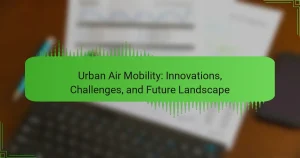Cargo drones are revolutionising logistics with their potential for efficient delivery solutions. Key technologies include advanced navigation, autonomous flight, and improved battery systems. Applications span healthcare, e-commerce, agriculture, and disaster relief. However, regulatory challenges and technical limitations must be addressed for broader adoption and integration.
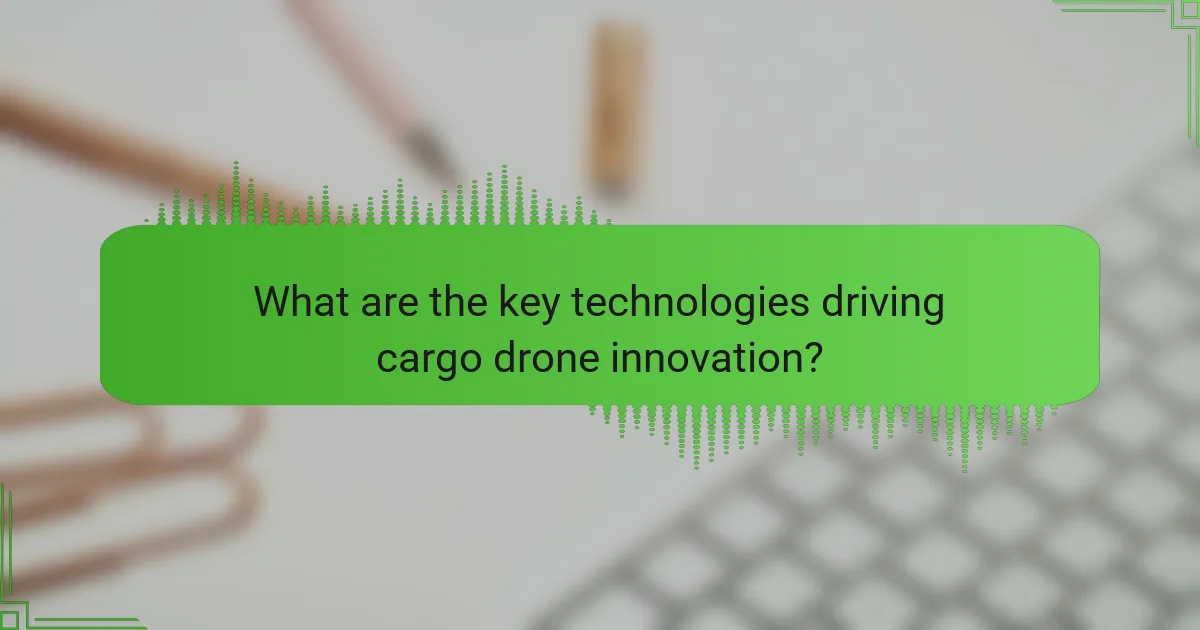
What are the key technologies driving cargo drone innovation?
Key technologies driving cargo drone innovation include advanced navigation systems, autonomous flight capabilities, and improved battery technology. These innovations enhance efficiency, safety, and operational range. For instance, LiDAR and GPS integration allows precise navigation in complex environments. Additionally, electric propulsion systems are evolving, providing longer flight times and reducing operational costs. The use of artificial intelligence is also increasing, enabling real-time decision-making and obstacle avoidance.
How do different propulsion systems affect cargo drone performance?
Different propulsion systems significantly impact cargo drone performance by influencing speed, range, payload capacity, and energy efficiency. Electric propulsion systems provide quieter operation and lower maintenance, while hybrid systems extend range and versatility. For instance, electric drones typically excel in urban environments due to reduced noise, whereas hybrid models can cover longer distances, making them suitable for rural deliveries. The choice of propulsion system ultimately shapes operational efficiency and application suitability.
What role does AI play in cargo drone navigation and safety?
AI enhances cargo drone navigation and safety through real-time data processing and decision-making. It enables drones to analyse environmental factors, avoid obstacles, and optimise flight paths. Advanced algorithms improve route efficiency, ensuring timely deliveries. AI systems also monitor drone health, predicting maintenance needs to prevent accidents. As a result, cargo drones can operate autonomously, increasing reliability and reducing human error.
Which materials are commonly used in cargo drone construction?
Cargo drones are commonly constructed using lightweight materials such as carbon fibre, aluminium, and plastics. These materials enhance durability while minimising weight, which is crucial for efficient flight. Carbon fibre offers high strength-to-weight ratios, aluminium provides structural integrity, and plastics are often used for various components due to their versatility. Additionally, some cargo drones incorporate composite materials that combine properties of different substances for improved performance.
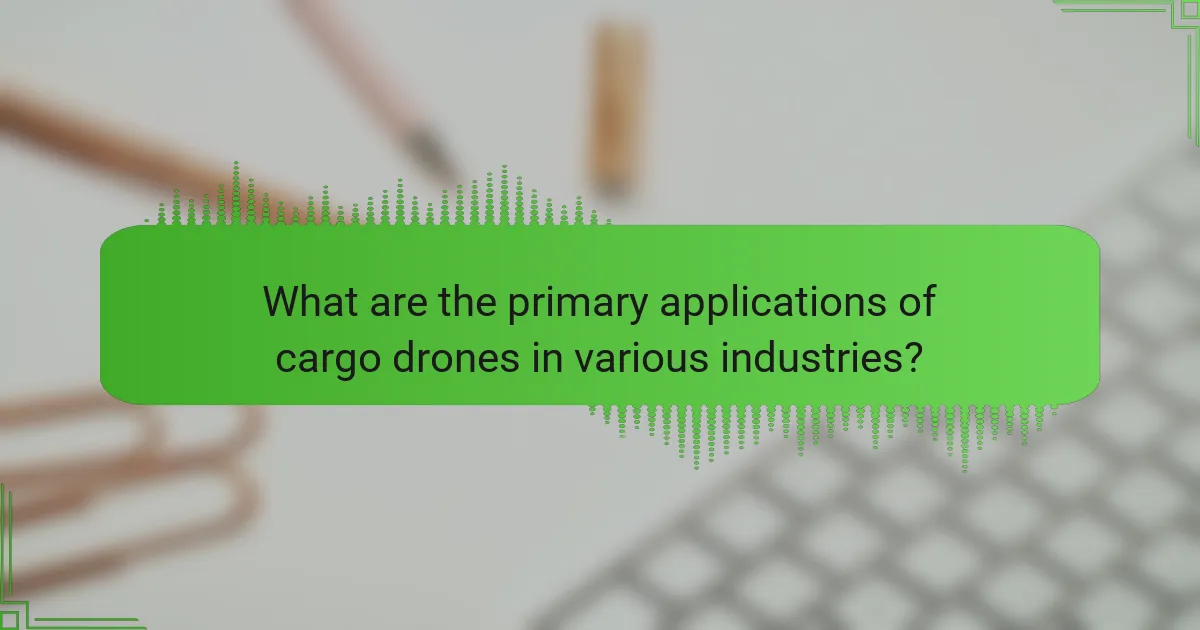
What are the primary applications of cargo drones in various industries?
Cargo drones are increasingly utilised across various industries for efficient delivery and logistics solutions. In healthcare, they transport medical supplies to remote areas, significantly reducing delivery times. The e-commerce sector employs cargo drones for rapid package delivery, enhancing customer satisfaction. Agriculture benefits from drones by enabling precise crop monitoring and distribution of supplies. Construction uses cargo drones to deliver materials to hard-to-reach sites, improving project timelines. Finally, disaster relief operations leverage cargo drones to deliver essential supplies quickly in emergency situations.
How are cargo drones transforming logistics and supply chain management?
Cargo drones are revolutionising logistics by enhancing speed, reducing costs, and improving delivery efficiency. Their ability to bypass traditional traffic routes allows for rapid transportation of goods, particularly in remote areas.
These drones can carry payloads ranging from small packages to larger freight, offering flexibility in various applications. For instance, companies are deploying cargo drones for medical supply deliveries, agricultural monitoring, and e-commerce logistics.
The future potential of cargo drones includes advancements in battery technology and autonomous navigation systems. As a result, their operational range and payload capacities are expected to increase significantly, further transforming supply chain dynamics.
What benefits do cargo drones offer in emergency medical services?
Cargo drones enhance emergency medical services by delivering critical supplies rapidly and efficiently. They reduce response times, especially in remote areas, ensuring timely access to life-saving medications and equipment. Cargo drones can navigate challenging terrains, bypassing obstacles that ground vehicles face. Additionally, they lower operational costs compared to traditional delivery methods, allowing for more resources to be allocated to patient care. The integration of cargo drones in emergency services demonstrates significant potential for improved healthcare outcomes.
How are cargo drones being utilised in agriculture for crop monitoring?
Cargo drones are increasingly utilised in agriculture for crop monitoring by providing real-time data and insights. These drones enable farmers to assess crop health, monitor irrigation, and detect pest infestations efficiently. Equipped with advanced sensors, they capture high-resolution images and data analytics, allowing for precise decision-making.
The unique attribute of cargo drones is their ability to cover large areas quickly, significantly reducing the time needed for traditional monitoring methods. As a result, farmers can implement timely interventions, improving yield and resource management. The integration of drone technology in agriculture exemplifies a shift towards precision farming, enhancing productivity and sustainability in the sector.
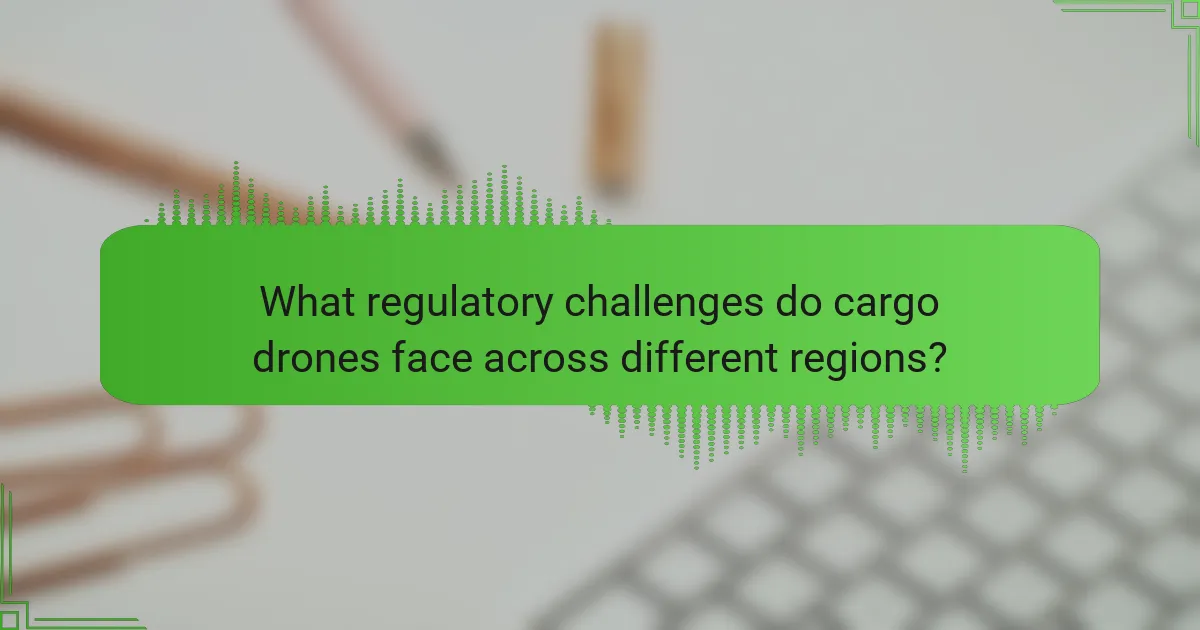
What regulatory challenges do cargo drones face across different regions?
Cargo drones face various regulatory challenges that differ by region. These include airspace management, safety standards, and privacy concerns. In North America, regulations focus on integration with manned aircraft, while Europe emphasises stringent safety protocols. In Asia, rapid technological advancements often outpace regulatory frameworks, leading to inconsistencies. Additionally, some regions lack clear guidelines on drone delivery operations, hindering commercial viability. Addressing these challenges requires collaboration between stakeholders and regulatory bodies to create cohesive frameworks that ensure safety and innovation.
How do airspace regulations impact cargo drone operations in urban areas?
Airspace regulations significantly influence cargo drone operations in urban areas by dictating flight paths, altitude limits, and safety protocols. These regulations ensure safe integration with manned aircraft and minimise noise and privacy concerns. Compliance with local laws affects operational efficiency, delivery times, and the scalability of drone logistics. Additionally, regulatory frameworks may vary by city, impacting the overall viability of urban cargo drone services.
What are the privacy concerns associated with cargo drone deliveries?
Cargo drone deliveries raise significant privacy concerns primarily related to data collection and surveillance. Drones equipped with cameras and sensors can inadvertently capture personal information, leading to potential misuse. Additionally, the tracking of delivery routes may expose sensitive information about individuals’ locations and habits. As cargo drones become more prevalent, regulations will be essential to mitigate these privacy risks while ensuring efficient delivery services.

What unique features differentiate specific cargo drone models?
Specific cargo drone models are differentiated by their payload capacity, flight range, battery life, and automation features. For instance, the DJI Matrice 600 has a payload capacity of 6 kg and a flight range of 5 km, while the Zipline drone can carry 1.75 kg over distances up to 160 km. Additionally, unique attributes such as vertical takeoff and landing (VTOL) capabilities or real-time tracking systems further distinguish these models. Rare features, like advanced obstacle avoidance technology, are also present in select drones, enhancing safety and efficiency in logistics operations.
Which cargo drones are designed for extreme weather conditions?
Several cargo drones are specifically engineered for extreme weather conditions, such as the DJI Matrice 300 RTK and the Griff Aviation 200. These drones feature advanced thermal insulation, robust materials, and enhanced stability systems to operate in harsh environments. Additionally, the Quantum Systems Trinity F90+ is designed to withstand heavy rain and strong winds, ensuring reliable performance. Their innovative designs allow for safe cargo transport in adverse weather, expanding operational capabilities in challenging climates.
What innovative payload systems are being developed for cargo drones?
Innovative payload systems for cargo drones include modular designs, automated loading mechanisms, and advanced sensor integration. These systems enhance efficiency and adaptability for diverse delivery needs. For example, modular payloads allow for quick configuration changes based on cargo type, while automated systems reduce labour costs and improve safety. Additionally, sensors can monitor payload conditions in real-time, ensuring optimal transport of sensitive goods. This combination of features positions cargo drones as vital tools in logistics and supply chain management.

How are cargo drones expected to evolve by 2025?
Cargo drones are expected to evolve significantly by 2025, enhancing delivery efficiency and operational capabilities. Innovations in battery technology will increase flight durations, while advancements in AI will improve navigation and safety. Regulations will likely adapt, enabling broader commercial use. Enhanced payload capacities will allow for diverse applications, including medical supply transport and e-commerce deliveries. As a result, cargo drones will play a crucial role in logistics and supply chain management.
What advancements in battery technology will enhance cargo drone range?
Advancements in battery technology, such as solid-state batteries and higher energy density lithium-ion batteries, will significantly enhance cargo drone range. Solid-state batteries offer improved safety and longevity, while advanced lithium-ion batteries can provide up to 300 Wh/kg, extending operational distances. Additionally, innovations in battery management systems will optimise energy usage, further increasing range and efficiency.
Which new markets are emerging for cargo drone deployment?
Emerging markets for cargo drone deployment include healthcare, agriculture, logistics, and disaster relief. These sectors benefit from rapid delivery, cost efficiency, and access to remote areas.
Healthcare is seeing increased interest, particularly in delivering medical supplies to underserved regions. Agriculture utilises drones for crop monitoring and delivery of agricultural inputs. Logistics companies are exploring drones for last-mile delivery, enhancing efficiency in urban areas. Disaster relief operations leverage drones to transport essential supplies quickly to affected zones.
Each of these markets demonstrates unique attributes, such as regulatory support in healthcare and the need for real-time data in agriculture. As technology advances, additional markets may emerge, further expanding the potential of cargo drones.
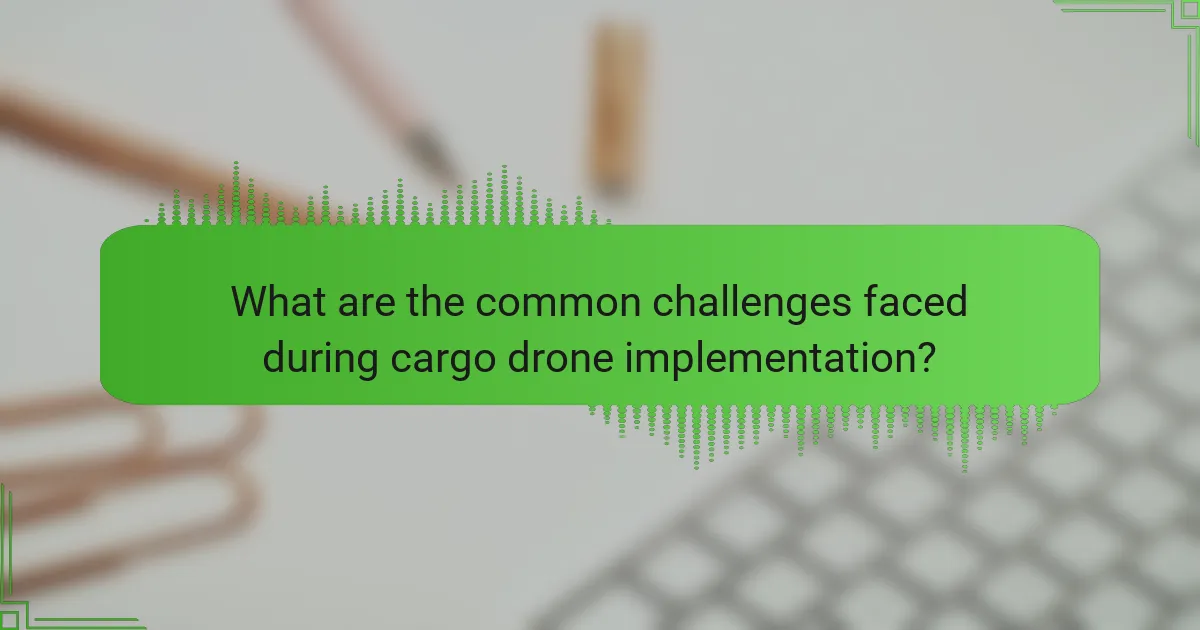
What are the common challenges faced during cargo drone implementation?
Cargo drone implementation faces challenges such as regulatory hurdles, technical limitations, and public perception issues. Regulatory frameworks often lag behind technological advancements, complicating approval processes. Technical limitations include payload capacity and battery life, impacting operational efficiency. Public perception can hinder acceptance, as concerns about safety and privacy arise. Addressing these challenges is crucial for successful integration into logistics.
How can operators ensure the safety and security of cargo drones?
Operators can ensure the safety and security of cargo drones by implementing stringent safety protocols and advanced technology. Regular maintenance and inspections prevent mechanical failures. Real-time tracking systems enhance security by monitoring flight paths and cargo integrity. Training personnel in emergency response procedures is essential for handling potential incidents. Additionally, utilising collision avoidance technology minimises the risk of accidents, while encryption protects data transmission during operations. These measures collectively enhance the reliability and safety of cargo drone operations.
What are the logistical hurdles in integrating cargo drones into existing infrastructure?
Integrating cargo drones into existing infrastructure faces several logistical hurdles. These include regulatory challenges, air traffic management, and compatibility with current delivery systems.
First, regulatory frameworks must adapt to accommodate drone operations, ensuring safety and compliance. Second, air traffic management systems require updates to track and integrate drone flights with manned aircraft. Lastly, existing delivery networks may need significant modifications to incorporate drone technology seamlessly.
These challenges highlight the need for collaboration between government agencies, technology developers, and logistics companies to create a cohesive operational environment. Addressing these hurdles is essential for realising the full potential of cargo drones in supply chains.
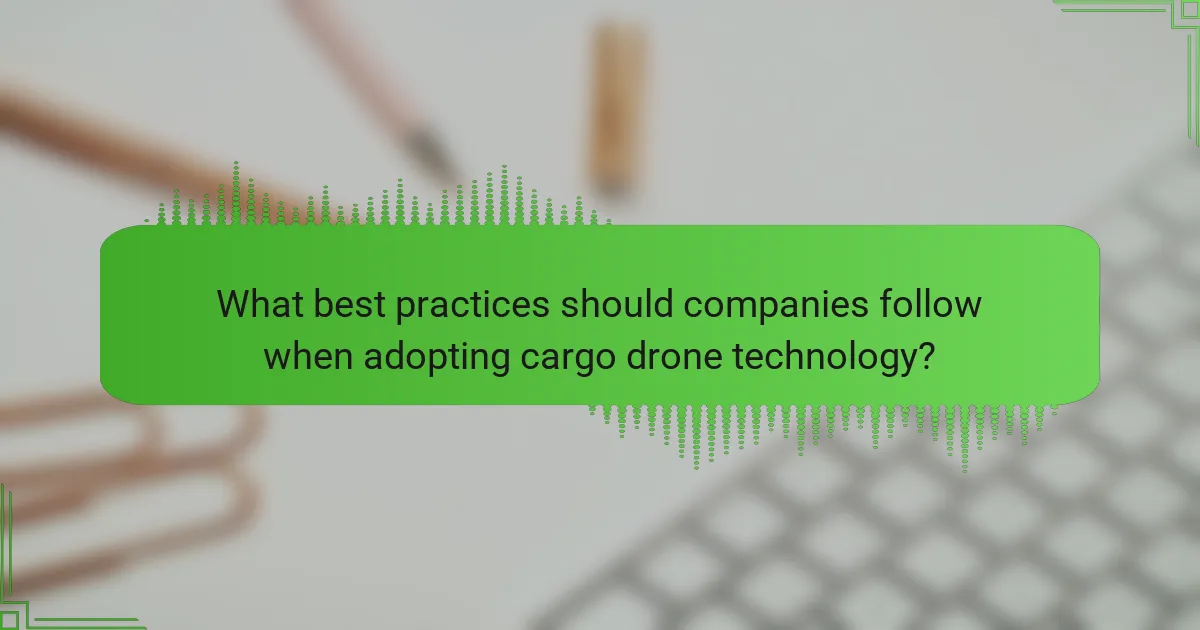
What best practices should companies follow when adopting cargo drone technology?
Companies should prioritise safety, regulatory compliance, and robust infrastructure when adopting cargo drone technology. These best practices ensure efficient operations and minimise risks.
1. Conduct thorough risk assessments to identify potential challenges.
2. Collaborate with regulatory bodies to ensure compliance with aviation laws.
3. Invest in advanced navigation and safety systems to enhance reliability.
4. Establish clear operational protocols for drone deployment and maintenance.
5. Train personnel extensively on drone technology and safety measures.
6. Monitor performance and adapt strategies based on operational data and feedback.
How can organizations optimise cargo drone routes for efficiency?
Organisations can optimise cargo drone routes by leveraging advanced algorithms and real-time data. Implementing route optimisation software enhances efficiency by analysing factors like weather, air traffic, and delivery urgency. Utilising machine learning can predict optimal paths based on historical data, reducing delivery times and costs. Regularly updating route parameters ensures adaptability to changing conditions, maximising operational efficiency.
What strategies can be employed to maintain cargo drone fleets effectively?
To maintain cargo drone fleets effectively, implement regular maintenance schedules, utilise data analytics for performance monitoring, and ensure pilot training.
Regular maintenance helps identify wear and tear, extending the lifespan of drones. Data analytics enables predictive maintenance, reducing downtime by anticipating failures. Training pilots on operational protocols enhances safety and efficiency, ensuring optimal fleet performance.


